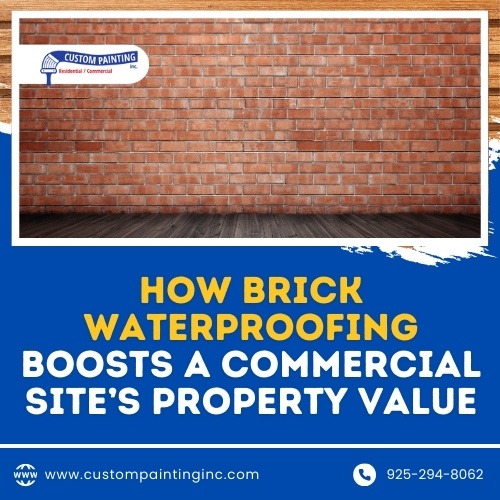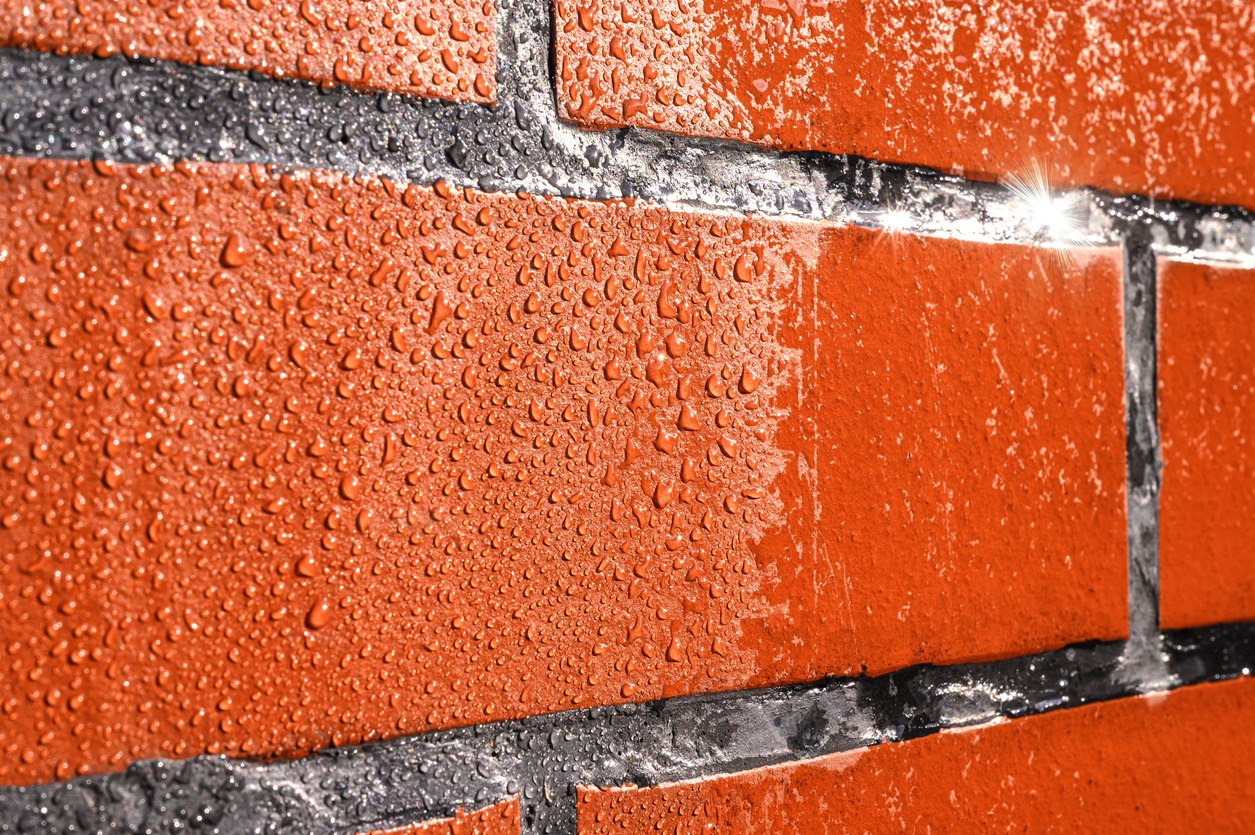For centuries, brick has been used for homes and buildings. But why is it popular up to this day? It is durable, has a timeless appeal, and can regulate temperature. Brick is made from clay, molded, and fired at high temperatures to create durable and resilient blocks.
Brick has excellent insulation and fire resistance, which help in energy efficiency and safety in homes and buildings. Because it is low maintenance and available in various colors, textures, and patterns, brick is still an attractive choice for interior and exterior applications.
The Concept of Waterproofing and Its Importance
Waterproofing is the process of making an object, structure, or person water-proof or water-resistant. In wet conditions or environments, this step is crucial to protect buildings from water intrusion, which can otherwise cause many sorts of damage like mold, rot, corrosion, and general weakening of the buildings’ materials.
Proper waterproofing ensures the safety and health of occupants, prevents costly repairs, and extends the lifespan of the building. It can be applied through various methods, such as sealants, membranes, and coatings, on the building’s interior and exterior surfaces.
The Basics of Brick Waterproofing
Brick waterproofing is the application of a protective coating or treatment to brick surfaces to prevent water from penetrating the bricks and causing damage such as efflorescence, mold growth, or structural issues. It helps prolong the brickwork’s life and maintain the structure’s appearance.
The common methods and materials used in waterproofing bricks:
- Silane and siloxane sealers – These penetrate the brick and create a water-repellent barrier while allowing the bricks to breathe.
- Acrylic sealers – These form a film on the surface of the brick, providing a barrier against water but can sometimes trap moisture within the brick.
- Masonry paints – Special paints designed to be waterproof can be applied to brickwork.
Distinction between waterproofing and damp-proofing:
- Waterproofing involves making the structure impervious to water, protecting it from water infiltration under heavy or frequent exposure.
- Damp-proofing is a lighter treatment that helps control moisture in the structure and prevents dampness, usually used in less severe conditions than waterproofing.
The Benefits of Brick Waterproofing
Brick waterproofing offers several benefits:
- Prevents water damage – Waterproofing bricks can prevent water from penetrating the brickwork, reducing the risk of water damage such as cracks, spalling, and efflorescence.
- Increases longevity – By protecting against water infiltration, brick waterproofing helps extend the lifespan of the brick structure.
- Reduces mold and mildew – Keeping bricks dry helps minimize mold and mildew growth, which can harm the structure and occupants’ health.
- Enhances aesthetic appeal – Waterproofing can help maintain the appearance of bricks by preventing staining and discoloration.
- Improves energy efficiency – Dry bricks provide better insulation, which can help maintain interior temperatures and improve energy efficiency.
- Protects against freeze-thaw damage – Waterproofing prevents water from entering the brick and freezing, which can cause cracks and deterioration.
- Easy maintenance – With waterproofing, brickwork is easier to maintain and clean, reducing the need for frequent repairs.
Impact on Property Value
Increased attractiveness to buyers
Waterproofed brick buildings are more appealing to property buyers for several reasons:
- Durability – Waterproofing protects the brick from moisture damage, such as cracking, mold, and efflorescence, leading to a longer lifespan for the building.
- Low Maintenance – Waterproofing reduces the need for frequent repairs and maintenance, saving the property owner time and money.
- Aesthetic appeal – Waterproofed bricks maintain their original appearance and color, enhancing the building’s visual appeal.
- Energy efficiency – Proper waterproofing can improve insulation and energy efficiency, making the property more comfortable and cost-effective.
- Resale value – Waterproofed buildings tend to have a higher resale value due to their improved condition and longevity.
Higher market valuation
Waterproofing brick buildings can contribute to higher market valuation and appraisals for several reasons:
- Protection against damage – Waterproofing helps prevent moisture from penetrating brick walls, which can cause structural damage, deterioration, and mold growth, extending the building’s lifespan and reducing maintenance costs.
- Enhanced curb appeal – A well-maintained brick building with waterproofing often looks more aesthetically pleasing, attracting potential buyers and increasing the property’s marketability.
- Improved energy efficiency – Waterproofing can prevent moisture from entering the building, helping maintain consistent indoor temperatures and reducing heating and cooling costs.
- Preservation of property value – Waterproofing protects the integrity of the brick and structural components, preserving the property’s value over time.
- Higher buyer confidence – Potential buyers often value properties that are in good condition and require minimal repairs, making a waterproofed brick building more appealing and potentially leading to a higher valuation.
Considerations Before Implementing Waterproofing
Assessment of the brickwork’s current state
Evaluating the existing condition of the brickwork before waterproofing is very important for several reasons:
- Identifying structural issues – A thorough evaluation can help identify any existing structural issues such as cracks, spalling, or loose bricks. Waterproofing a deteriorating structure could exacerbate problems by trapping moisture within the brickwork.
- Determining the appropriate treatment – Not all waterproofing products are suitable for all types of brickwork. Evaluating the condition of the brickwork will help you choose the most appropriate treatment that won’t harm the brick.
- Preventing trapped moisture – Applying waterproofing over brickwork that already has moisture damage can trap moisture inside, leading to further deterioration and potentially severe structural damage over time.
- Ensuring proper cleaning – Before waterproofing, it’s crucial to clean the brickwork properly to remove dirt, debris, and old sealants. A thorough evaluation helps determine the best cleaning methods and products.
- Assessing the need for repairs – In case of issues like loose mortar joints or damaged bricks, these must be repaired before waterproofing to ensure the treatment’s effectiveness and longevity.
- Preserving appearance – Evaluating the brickwork condition helps ensure the chosen waterproofing treatment will maintain the appearance of the brick rather than altering its color or texture.
- Cost-effectiveness – Proper evaluation allows for a more targeted approach, potentially saving money by addressing only necessary areas and preventing future expensive repairs.
Choosing the right materials and professionals
When selecting suitable waterproofing materials, consider the following tips:
- Material compatibility – Ensure the material is compatible with the type of structure you are waterproofing (e.g., concrete, wood, or metal).
- Climate suitability – Choose materials suitable for your area’s climate and environmental conditions (e.g., UV-resistant for sunny climates).
- Type of waterproofing – Different types of waterproofing, such as membranes, sealants, or coatings, are suitable for various applications; choose based on your needs.
When selecting qualified contractors, keep these tips in mind:
- Experience and reputation – Look for contractors with experience and a good reputation in the industry.
- References and reviews – Ask for references and read reviews from previous clients to gauge their work quality and reliability.
- Licensing and insurance – Verify that the contractor is licensed and insured to protect against potential liabilities.
- Warranty and after-sales service – Choose contractors who offer warranties on their work and good after-sales support.
Cost vs. benefit analysis
Investing in brick waterproofing can indeed have significant upfront costs. However, the long-term savings on maintenance, energy, and potential damage repair can offset the initial cost over time. Here’s how:
Investment costs
- Materials – Depending on the waterproofing method used, such as sealants, coatings, or treatments, material cost can vary.
- Labor – Professional application may be necessary, especially for larger or more complex projects, adding to the cost.
- Preparation – The brick surface may need to be cleaned and repaired before applying waterproofing, which can increase costs.
Long-term savings
- Prevention of water damage – Waterproofing can prevent moisture from seeping into brickwork, avoiding potential damage such as cracks, erosion, and mold growth.
- Reduced maintenance costs – By protecting the brick, waterproofing can extend its lifespan and reduce the frequency and cost of repairs and maintenance.
- Energy efficiency – Properly sealed brickwork can improve insulation, leading to potential savings on heating and cooling bills.
- Property value – Waterproofing can maintain or enhance a property’s appearance and structural integrity, potentially increasing its value.
Regulatory vs. Legal Aspects
Building codes and regulations concerning brick waterproofing are designed to ensure the buildings’ structural integrity, safety, and longevity. They address the prevention of water infiltration in brick structures, which can lead to damage, deterioration, and other safety hazards. Here is an overview of these codes, regulations, and compliance issues:
- Moisture control – Building codes typically require measures to control moisture ingress in brick structures. They can include requirements for proper flashing, weep holes, and drainage systems to direct water away from the structure.
- Material standards – Codes may specify standards for waterproofing materials such as sealants, coatings, and membranes. These materials should meet specific performance criteria for durability and effectiveness in preventing water penetration.
- Installation guidelines – Proper installation of waterproofing materials is critical. Building codes often provide guidelines for correctly applying and installing these materials to ensure effectiveness and compliance.
- Testing and inspection – Codes may require testing and inspecting waterproofing systems during and after construction to ensure they meet the specified standards. It can include water testing to check for leaks and proper installation.
- Maintenance requirements – Ongoing maintenance is crucial for the continued effectiveness of waterproofing systems. Codes may require regular inspections and maintenance of waterproofing materials to prevent long-term damage.
- Compliance issues – Compliance with building codes and regulations can involve several steps:
- Design and planning – Architects and engineers must design the building according to local codes and regulations, including appropriate waterproofing measures.
- Permitting – Building plans must be submitted to local authorities for review and approval before construction begins. This process ensures that the proposed design meets code requirements.
- Construction oversight – During construction, building inspectors may visit the site to ensure work is being carried out according to the approved plans and codes.
- Final inspection – After construction is complete, a final inspection is usually required to verify that the building meets all codes and regulations.
- Legal standards – To ensure legal standards are met, contractors and builders should:
- Stay informed of current building codes and regulations.
- Use certified and approved waterproofing materials and methods.
- Maintain proper documentation of materials, inspections, and compliance.
- Correct any deficiencies identified during inspections.
Adherence to these codes and regulations is crucial for legal compliance and to avoid potential issues such as structural damage, mold growth, and legal disputes. Builders should work closely with local building authorities and professionals to ensure that all waterproofing measures meet the necessary standards.Conclusion
Brick waterproofing is an essential preventative and protective measure for your commercial buildings. While investing in brick waterproofing can have significant upfront costs, it can save you money in the long run. It makes sense to hire the best painters in the Bay Area who also offer brick waterproofing services, as they provide the best products, techniques, and solutions, ensuring long-lasting protection for your brick buildings. They can also help you navigate regulatory and legal requirements specific to California, ensuring that your brick waterproofing project complies with local building codes and regulations.
If you’re looking for effective brick waterproofing solutions for your residential or commercial property in the Bay Area, contact Custom Painting, Inc. today by phone at 925-294-8062 or message us to protect your building from the elements and preserve its beauty and value for the years to come.


